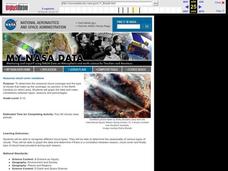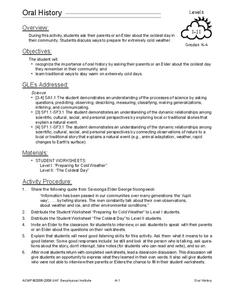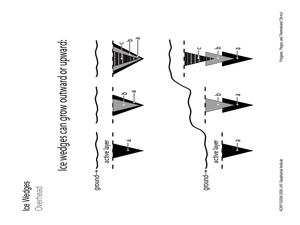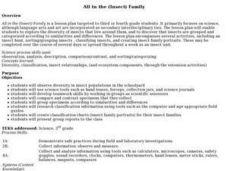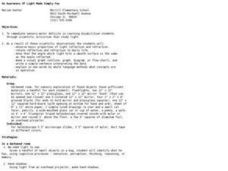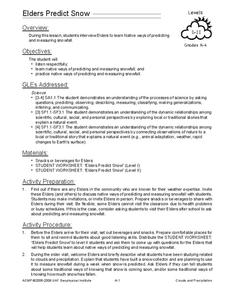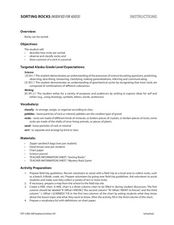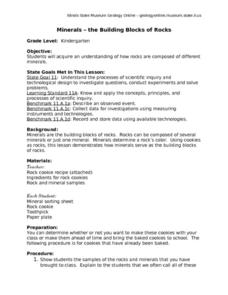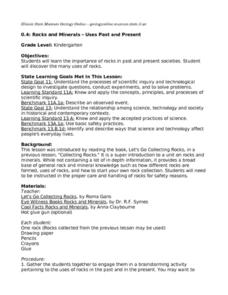Curated OER
Seasonal Cloud Cover Variations
Students recognize different cloud types. They determine the seaonality of various types of clouds. They graph the data and determine if a correlation exists between season, cloud cover and type of clouds most prevalent during each season.
Curated OER
Journal of the Stars
Students receive balloons representing the "Life Cycle of the Stars." As the attached script is read, students follow the directions for the color of balloon they are given. Students chart the results for their star. They plot data from...
Curated OER
Reflections
Students are given materials with various textures and light sources to investigate specular reflection, diffuse, reflection, angle of incidence, and angle of reflection. Students draw and label an everyday scenario showing specular and...
Curated OER
Trouble in the Troposphere
Students Use data sets from MY NASA DATA to produce graphs comparing monthly and yearly ozone averages of several U.S. cities. They analyze and evaluate the data and predict trends based on the data. In addition, they discuss and...
Curated OER
Oral History
Young scholars interview a Native Elder to learn about oral history and cold weather. In this weather lesson, students ask an Elder about the coldest day they remember in their community and complete two worksheets for the topic.
Curated OER
Polygons, Pingos, and Themokarst! Oh MY!
Learners complete activities to learn about the common land features in Alaska. In this land study lesson plan, students study an overhead for permafrost features. Learners define ice wedge polygons, thermokarst, and pingos. Students...
Curated OER
Permafrost
Students use a thermometer to analyze soil temperature data to determine which soil sample is normal, and which one is permafrost. For this permafrost lesson plan, students participate in a hands on activity where they identify the...
Curated OER
Leonardo Lives
Students investigate the concepts of force and motion. They describe how motion is created by force. Also students define a simple machine and the factors of application to creating force or motion. They analyze the plans of Leonardo De...
Curated OER
Matter
Fifth graders investigate the structure of matter. They examine pictures of atoms and molecules and discuss their relationships, and construct a model of a molecule using toothpicks and gumdrops.
Curated OER
Stratospheric Ozone
Students explore about the structure of Earth's atmosphere and about the stratospheric ozone. They discuss how it is produced and destroyed, where it is located, why it is important, and how it is changing. Students investigate about...
Curated OER
Exploring Ecosystems
Fourth graders investigate ecosystems. In this ecosystem lesson, 4th graders explore producers, consumers, and decomposers and study the interdependence of each.
Curated OER
All in the (Insect) Family
Students participate in a series of activities in order to explore the diversity of insects. They explore how insects are grouped and categorized.
Curated OER
Solids, Liquids, and Gases
Students explore the three main forms of matter: solid, liquid, and gas. They examine concrete examples of each, using their five senses and "experimenting" to find differences in them. They find pictures of each, cut them out and past...
Curated OER
Alternate Theory of Color Perception
Students use the color wheel, matches, masking tape, and slides to view an alternate theory of color perception. In this color perception lesson plan, students discuss the different theories and processors.
Curated OER
The Next Logical Step in Astronomy
Students research future astronomy endeavors and how the exploration with contribute to astronomy and humanity. In this astronomy lesson plan, students research, present, and debate the topics as a class.
Curated OER
How Effective is Perspiration at Cooling?
Students collect data on the cooling of water in two different test tubes, one that is wrapped in wet newspaper and one in dry newspaper. They then relate this cooling effect to the body's perspiration.
Curated OER
An Awareness of Light Made Simply Fun
Learners with sensory perception issues discover the properties of light through a series of excellent hands on activities. They look at beams of lights in a darkened room; use a kaleidoscope and optical illusions as they experience the...
Curated OER
Elders Predict Snow
Students interview Native Indians to learn their ways for predicting and measuring snowfall. In this weather measurement lesson plan, students invite a Native Elder to their classroom to tell them about how they predicted weather....
Curated OER
Connect the Species
Fourth graders, in pairs, explore energy transfer and species interrelationships by viewing slides on a microscope. hey explore phytoplankton (producers) and zooplankton (consumers)
Curated OER
Sorting Rocks
Students devise a rock word web and sort rocks by applying the categories they discuss.
Curated OER
Minerals- the Building Blocks of Rocks
Students investigate how rocks are composed minerals by dissecting rock cookies.
Curated OER
Rocks and Minerals- Uses Past and Present
Students investigate the use of rocks in past and present societies. They examine how important rocks are.
Curated OER
Limiting Reagent
Students work in small groups with a small set of 8 nuts and 5 bolts to assemble into combinations of 1 nut: 1 bolt, and 2 nuts: 1 bolt. They explore the outcome and discuss. Then a student mixes two clear, colorless solutions together...
Curated OER
Sound
First graders investigate sound and recognize the importance of hearing. They listen to and identify sounds in the environment, classroom, and on a pre-recorded tape. The students classify each type of sound and participate in a Sound...
